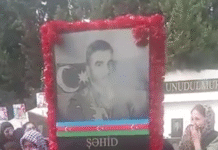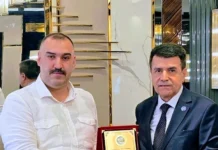The Haji Zeynalabdin Tagiyev Medal of Honor, established by the CIPDH-FD International Online News Agency, was presented to BABAYEV RASHAD BASHIR oglu and HASRATOV ANAR ZULFUGAR oglu. .info ”website founder Mardan Eminov and Editor-in-Chief Aybaniz Rustamova. DETAILED VIDEO
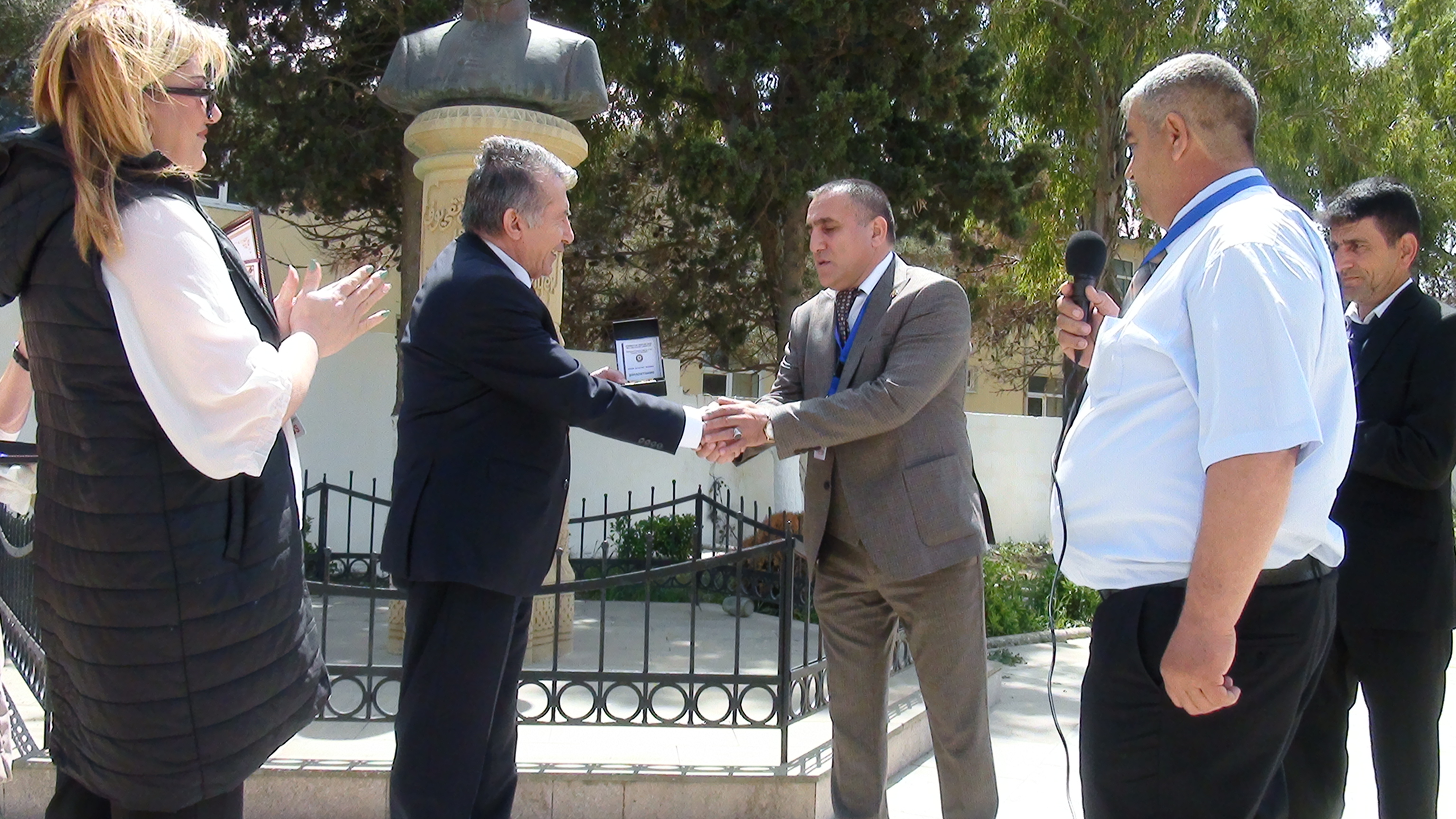
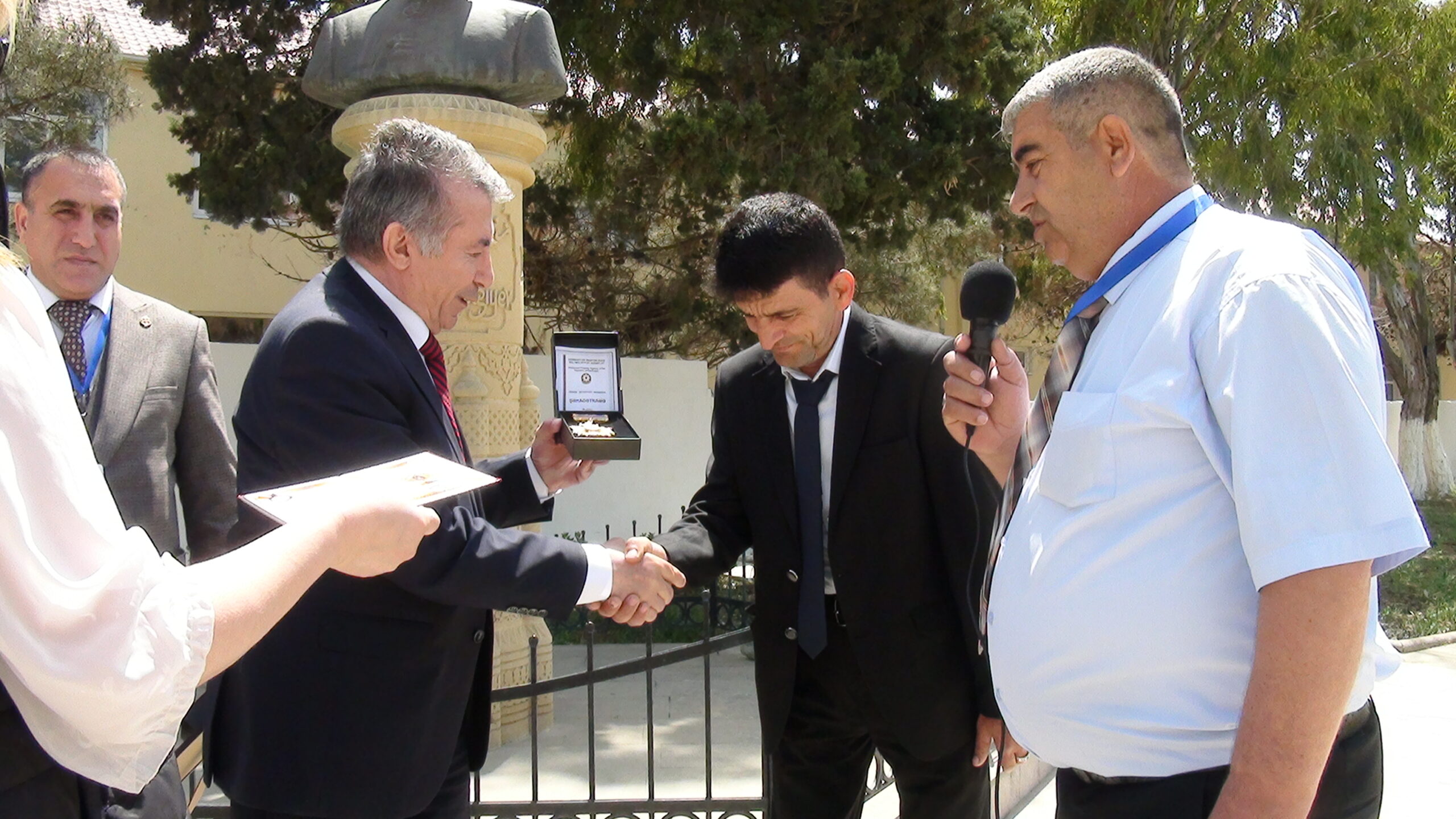
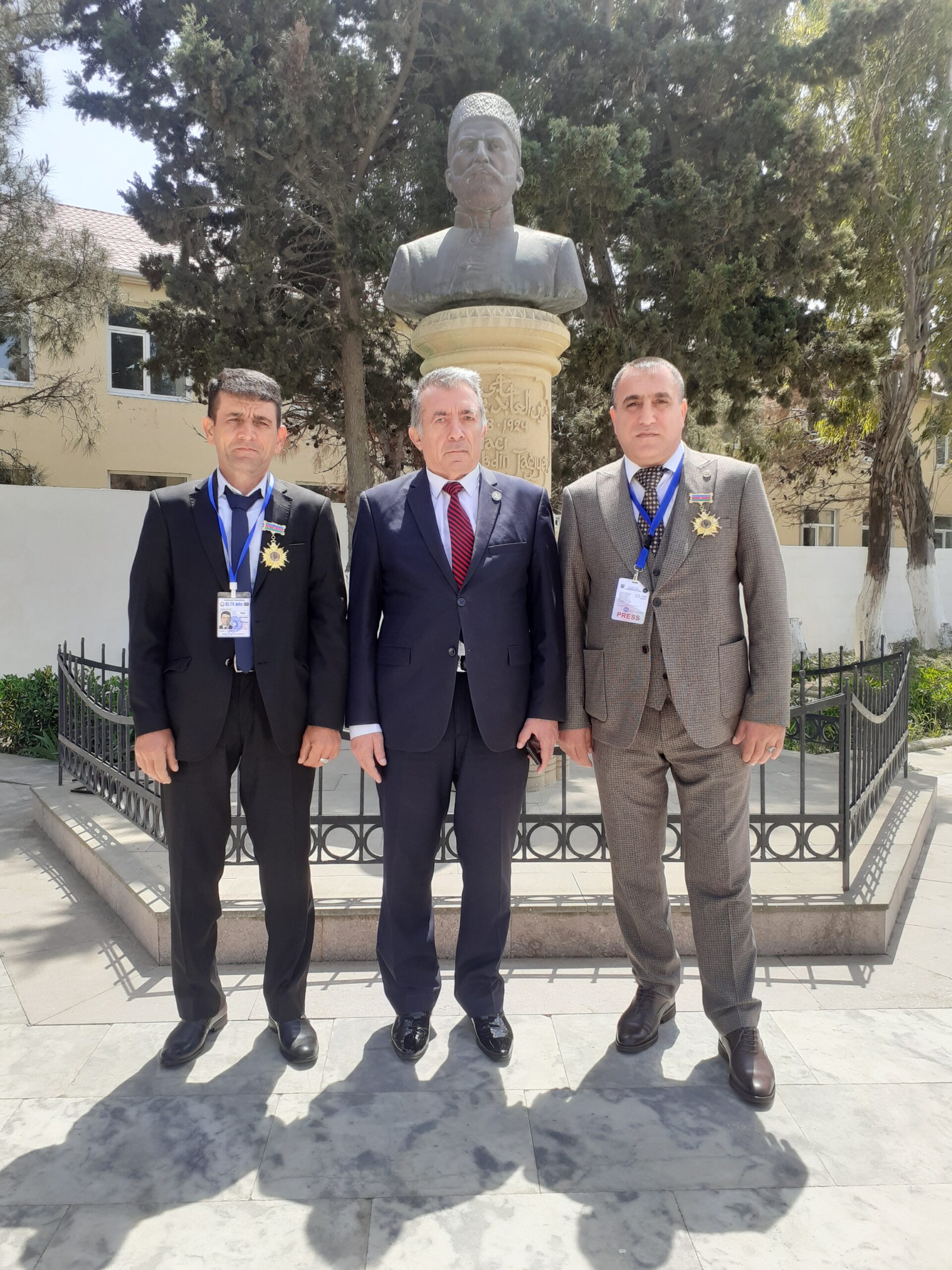
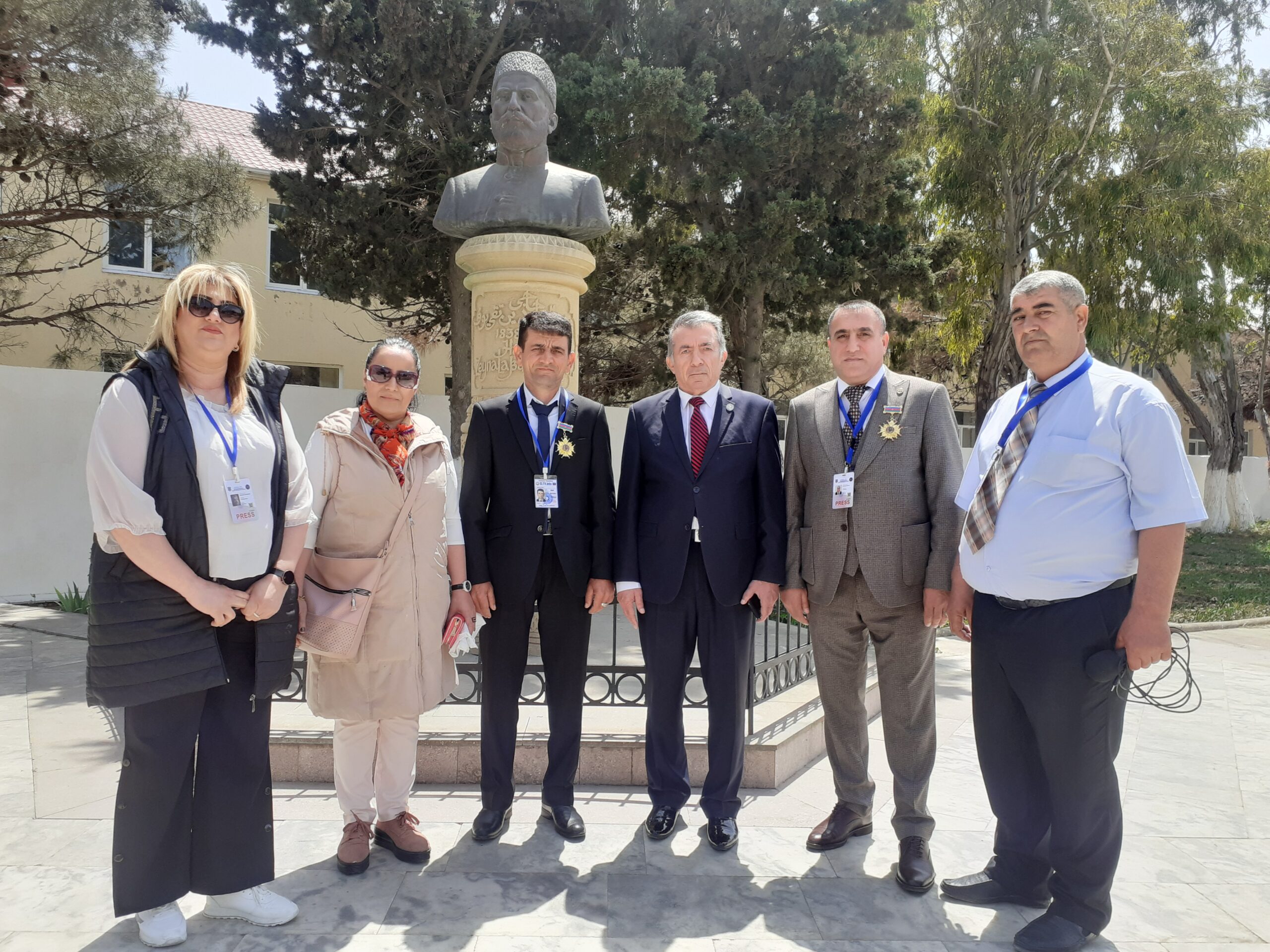
Haji Zeynalabdin Tagiyev was born in 1838 (in another source in 1823) (according to some sources in 1838) in Baku to a poor shoemaker family. His mother, Umm Zeynalabdin, died when he was 10 years old. Little Zeynalabdin was restrained and hardworking from childhood. At the age of ten, his father hired him as an assistant to a builder. By the time he was 12, he was already a stonecutter, and at the age of 15, he began building. After a while, he became known as a master builder and organizer. Having collected some funds, Tagiyev has been organizing house construction and transportation for 20 years. He also personally supervised his subsequent construction work. In the buildings he built, for example, in the building where he lived and in the building of the girls’ gymnasium, which he personally opened, his line is felt.
Haji Zeynalabdin has been married twice. His first wife was his cousin Zeynab khanum. Mrs. Zeynab had two sons and a daughter. Sons: Ismail, Sadig and daughter Mrs. His second wife was Sona, the daughter of the famous lieutenant general Balakishi bey Arablinsky. The eldest of Arablinsky’s two daughters was the wife of Haji’s son Ismail. While Haji was a son, Balakishi saw and liked Sona, the youngest daughter of bey Arablinsky, and married her. In other words, Haji was a child with his son. Mrs. Sona was married to 73-year-old Tagiyev when she was 16 years old. Balakishi bey gave his youngest daughter to Haji to share Tagiyev’s property. Mrs. Sona Tagiyev had three daughters and two sons. Daughters: Leyla, Sara and Suraya. His sons Muhammad and Elijah. Mohammad committed suicide in Lankaran while being an officer of the Dikaya Division, and Ilyas fell ill and died.
She married Ali Asadullayev, son of Leyla Shamsi Asadullayev. They had children named Ali, Nadir, Gulnar and Zeynal. Zeynal was born in Turkey. Ali Asadulliyev took his family with him in the 1920s and emigrated first to Iran and then to Turkey, and then the family moved to Paris. Their daughter Gulnar Asadullayev moved to Istanbul with Leyla Asadullayeva after graduating from the Sorbonne University in Paris. Leyla Asadullayeva died in 1948 in Istanbul. The following words are inscribed on his tombstone:
«Leyla Asadullah, daughter of Haji Zeynalabdin Tagi.» Baku January 17, 1896, Istanbul February 23, 1948. «
The name of Leyla Asadullayev is found in the magazine «Yeni Kafkasya». The report «The first anniversary of the death of Haji Zeynalabdin Tagiyev» reads:
«Haji Zeynalabdin Tagiyev, an Azerbaijani philanthropist, died in Baku a year ago. Last Friday, Leyla Khanum and her son-in-law Asadullahzadeh Ali Bey celebrated Mawlid at the Teshvikiye Mosque to commemorate the deceased. Azerbaijani refugees and local Turks also attended the Mawlid.»
Leyla Asadullayev’s name is also found in the «Salvation» magazine. Thus, in a report on the confrontation between Mohammad Amin Rasulzadeh and one of the leaders of the North Caucasus, Heydar Bammat, his name was mentioned and a letter was published:
«Many Azerbaijanis, including the family of the late Alimardan Bey, refused to accept the Caucasus magazine sent to them and sent it back. As an example, with the permission of the late Haji Zeynalabdin Tagiyev’s daughter, Leyla Asadullah, a well-known Azerbaijani figure, we publish a copy of the letter sent to the office: «Dear Heydar Bey! I am sending back the Caucasus. I read it carefully. I did not find anything interesting to me except the hateful speeches that hurt my work. In addition, young people grow up in my home, what I read. Reading «Caucasus» has only a negative effect on the patriotism of the soul. Sincerely, L. Asadullah «
He later tried his hand at trade and light industry. In both, he succeeds with his abilities, owning shops and manufactories. He was also one of the largest exporters of Baku oil via the Caspian Sea and the Caucasus Railway. As a result of purposeful measures, Tagiyev was one of the first national industrialists to strike a blow at the colonial character of the Azerbaijani economy.
In 1870, Tagiyev already had a kerosene plant with two boilers. Along with the kerosene plant, he founded Haji Zeynalabdin in 1872.
In 1872, when the oil lands were put up for auction, Tagiyev and his two partners rented land in Bibi Heybat and began drilling wells. But in five years there were no results, costs increased, and oil did not come out. The partners decided to get out of the «harmful business». Zeynalabdin had to return the capital invested by them. Nevertheless, he persistently searched for «black gold». In 1878, an oil fountain hit one of the four wells. From that moment, Tagiyev’s company became one of the leading oil companies. As a result, his income began to grow rapidly. Three years later, Tagiyev’s company owned 30 desiatins of oil fields in Balakhani and Bibi Heybat, two schooners for the transportation of oil products, warehouses in Tsaritsyn (now Volgograd), Nizhny Novgorod, and Moscow, and two white oil and lubricating plants. The company’s annual efficiency was about 1 million barrels of raw and processed products.
He was elected honorary chairman by all the charities of the Muslim, Russian, Armenian and Jewish communities in Baku. During this period, Baku became a real oil empire. In the villages around Baku, land was bought by Russian and foreign investors, and oil rigs were built there. Haji is also interested in this and leaves the contract and gets involved in oil business.
In 1882, Tagiyev was awarded the rank of merchant of the 1st guild. In 1896, his oil company reached its peak in production. It produces 32 million pounds (512 kg) of oil.
In connection with the establishment of the Mazut company, the Baku-Batumi oil pipeline joint-stock company was established under the leadership of local rich man Cholag Agabala Guliyev. This oil pipeline, considered a huge construction at the time, would start in Baku, cross the Kura Plain, cross the foothills of the Caucasus Mountains and the slope of the Suram Fortress, cross the Reon Plain for 800 kilometers and connect the Caspian coast with the Black Sea coast. Baku oil would open the way to the oceans, distant countries and international markets. The extension of the pipeline began in 1897 and was completed in 1907. On October 29, 1897, when the Russian Society for the Production of Petroleum and Liquid Fuels (or Oleum) was established in London, Tagiyev became one of the six members of the Council.
In addition, Tagiyev is rapidly developing his cooperation with the Caspian Union, where until 1889 he worked for 738 shares, 3 ships with 100 to 250 workers in different years, and two dry docks (with G. Sh. Dadashov). joint) and had a bridge.
In 1897, Tagiyev sold his oil fields to a British company and invested in the non-oil sector. In 1900, he opened the first textile factory in the Caucasus. The Baku textile factory he built is the beginning of a new field of production in Azerbaijan. In order to provide the textile factory with raw materials, Tagiyev bought a plot of land in the Yevlakh region for cotton planting and in 1909 built a cotton ginning plant in Javad. Tagiyev also organized the trading house, which is considered to be the largest shopping center in Baku.
Emperor Nicholas II’s brother, Grand Duke Mikhail Alexandrovich, married a Polish girl, abdicated, and asked Tagiyev to allow him to hunt and rest in the woods around Yevlakh. He sent Haji a gift of a gold wheel decorated with jewels. He bought a 300-kilometer-long plot of land from the Azerbaijani shores of the Caspian Sea to the shores of Dagestan, including Derbent and Port-Petrovsk. He had leased the lands on the banks of the Kura from the state.
Tagiyev, who invested heavily in the fishing industry in 1890, owned large fishing grounds. He built a refrigeration plant, an ice factory and a tub plant in Makhachkala to store fish products.
Haji Zeynalabdin Tagiyev, seeing that fishing was weakening, threw the gold ring into the fish’s mouth and released the fish into the sea. And when the fishermen heard this, they rushed into the sea to catch the fish.
Since 1899, H.Z. Tagiyev has joined the energy sector. His activity in this direction led to the establishment in 1899 of the joint-stock company «Energy Power». Here Tagiyev worked as a deputy chairman. By the beginning of the 20th century, the joint-stock company had two power plants in the White City and Cape Bayil.
FIGHT AGAINST THOSE WHO OBSTACLE GIRL SCHOOL OPENING
The local clergy opposed the opening of the girls’ school. The clergy were outraged by the offer to educate the girls and stirred up the crowd. The old-fashioned clergy threatened to pour white oil on the door of Gazi Mir Mohammad Karimi, who approved the proposal to open a school. The old-fashioned, conservative people of the time also wanted to kill Haji Zeynalabdin Tagiyev because they considered it a great sin for Azerbaijani girls to read. «The blacksmith, a black-robed cleric, a broad-shouldered, bearded pilgrim, appeared and talked about Ismati-Niswan, quoting verses from the Qur’an, events and evidence from the Prophet, the Caliph and the Imams, and called it blasphemy. Haji Zeynalabdin Tagiyev was accused of secular activities. Gunners with daggers and daggers threatened «
However, Haji’s prestige among the people and the protection of the people around him did not allow this atrocity to take place. In order to silence the Muslim blacks, Haji Zeynalabdin Tagiyev gave a lot of money and gifts to the influential Molla Mirza Mohammad oglu and sent them to the holy places — Mecca, Medina, Karbala, Cairo, Istanbul, Tehran. Get official documents confirming that Muslim girls, like boys, can study in modern schools in addition to Sharia schools. There is nothing illegal in this sacred work. Haji’s measures did not work. Therefore, he was forced to address the clergy in the mosque: “People, it is important that our girls study in time. His eyes are wide open and he is pleasantly treated.
Each of our young people who go to England and France to study brings a wife there. Because they don’t catch metaphors with our daughters, they can’t live. Children born to foreign wives inherit all our wealth. If this happens, our ancestral hearth will remain without the Qur’an, without prayer, without Sharia. In the new schools, girls will be taught Islamic law, sewing clothes, weaving, cooking, reading and writing in Muslim (Azerbaijani) and Russian, science, and education. What’s wrong here? Mullah Ali Haji Khalil oglu! Listen to! I do not want to make girls rude, I do not call them to be open with non-mahrams. A middle-aged girl in her twenties was stabbed day and night and almost died. You brought Lopabig Ambarsum to the doctor, he examined his daughter, he treated her, and she survived. Now, let me see, if Lopabig Ambarsum had a Muslim wife doctor instead, what would be the law? We need a lot of wife doctors and teachers. I decided to open that school after we were called savages from the kingdom. I poured a lot of money and built a building for this purpose. Those who teach will be smart. ”
In 1873, he rented a place and drilled an oil well. In 1888, H.Z. Tagiyev was the honorary patron of the secondary technical school opened in Baku from 1897, and from that year he provided financial assistance to this school.
HZ Tagiyev opened a gardening school in Mardakan. Tagiyev covered the expenses of the gardening school, which started operating in 1895.
In 1896 he paid for the schools opened in Ganja and Nakhchivan, in 1897 in Shamakhi, and in 1906 in Tbilissi (Tbilisi). Tagiyev paid a large sum of money to establish Baku State University.
The Republic of Azerbaijan sent 100 people to study abroad at the expense of the state. 10 of them went to England, 23 to Italy, 45 to France, 9 to Turkey, and 13 to Germany and Russia. HZ Tagiyev also provided financial assistance to those students.
Haji Zeynalabdin Tagiyev built the first girls’ school in Baku in 1901 at a cost of 300,000 manat. According to some sources, Ms. Sona proposed the construction of a girls’ school. Because Mrs. Sona, who was Haji’s wife at a young age, could not get an education. It was the only girls’ school in the whole Caucasus. Construction of the building began in 1898. It is ready in 1900. This school is located on Nikolayevsky (Communist) Street (the building of the Manuscripts Fund of the Academy of Sciences of the Azerbaijan SSR). The building of the girls’ school is architecturally in the national-romantic style of Azerbaijani architecture. The wall on the main facade is made of white stone and gold.
Haji Zeynalabdin Tagiyev is known throughout Russia, first of all, for his patronage and enlightenment. His enlightenment services began mainly in the early twentieth century. This was not a coincidence. After the 1905 revolution, the government’s October Declaration revived cultural and educational activities in the country. A number of charitable societies have been established throughout the country. Newspapers and magazines began to be published. The establishment of these societies and the publication of newspapers and magazines are primarily associated with Tagiyev’s name. In this case, Tagiyev played a kind of organizing role. Charitable societies were established either with Tagiyev’s personal participation and funds, or with his close assistance. In addition, at Tagiyev’s expense, in 1885, Baku’s main newspaper, Kaspi, was published. The passage (BUM), designed by architect K. B. Skurevich in 1896, is still one of the best shopping centers in the city.
The first charity was the Muslim Charity Society, founded in 1905. In addition, Haji Zeynalabdin Tagiyev was closely involved in the establishment of «Publishing and Enlightenment» and «Salvation» societies.
At that time, prisoners were kept on the island of Nargin. When the people came and went, they suffered terribly. In the end, they appeal to Zeynalabdin to help us in this work and to solve our problems. He also gave the prison a five-storey building (now a confectionery factory) built between Guba (Fuzuli) Square and Coal Square, which was considered a remote part of the city at that time. According to other references, a new high-ranking official will be appointed to Baku. Haji goes to see him and says that if you need any help, do not be ashamed, tell me, I am not negotiating anything from the kingdom. A senior official explained, “We keep prisoners on the island of Nargin, and workers spend a lot of time going back and forth. They also suffer; If possible, help us in this work. » Haji Zeynalabdin gives the completed mill building to the government for the prison. He transports imported mill equipment to the area where the textile factory is located, where he builds a mill. He and his family built a private house near the factory to live in and stayed there from time to time.
Construction of Baku-Shollar water pipeline
Tagiyev also allocated money from his own funds for the construction of the Baku-Shollar water pipeline. An expedition team of engineers invited by Lindley from abroad discovered that there was clear, pure spring water in the forest northeast of Khudat. However, the construction of the Shollar pipeline, which will bring coolness and prosperity to the people of Baku, was delayed on the one hand due to lack of funds and on the other hand due to the propaganda of opponents of the project. Only after Tsar Nicholas II issued a decree on October 6, 1909, allowed the city of Baku to issue bonds for no more than 27 million rubles, did the Shollar water pipeline project enter an active phase of construction. [32] Thanks to the determination and perseverance of the author of the project, Lindley, all the equipment needed for the construction of the pipeline is imported. Even during the height of the First World War, such construction work continued unabated. The construction of the pipeline, warehouses and the city network is accelerating. Finally, thanks to the strong will and hard work of V. Lindley and his team of specialists, the Baku Duma and its Azerbaijani deputies, the city administration, thousands of Azerbaijani peasants working in Baku, Baku workers, in December 1916 the first stage of the Shollar-Baku water pipeline was built. Today, the construction of a 160-kilometer water pipeline that provides Baku with the best drinking water is completed.
Death
With the occupation of Azerbaijan by Soviet Russia on April 28, 1920, the situation changed radically. People’s property is being confiscated, national cadres and intellectuals are being persecuted, and everything is in Russia’s interests. At the request of the local population, Tagiyev is given the opportunity to choose a property on the instructions of one of the leaders of the new government, Nariman Narimanov. He chooses only a country house in Mardakan from his former possessions.
Haji Zeynalabdin Tagiyev died on September 1, 1924, at half past eight in the evening, at the age of 101 (according to some sources, at the age of 86) and was buried on September 4. A large crowd had gathered for his funeral. People brought food for the mourning from all over Baku and surrounding villages.
With the help of Nariman Narimanov, an obituary was published in the Baku newspapers «Communist» and «Bakinskiy rabochiy».
Rewards and awards
Order of St. Stanislav
Order of Shiri-Khurshid


